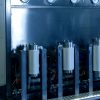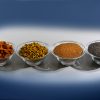Exenia Group Srl is able to create intermediate products made from vegetables: extracts with advanced technologies and with different processing steps to arrive at high efficiency and high bioavailability intermediates for the pharmaceutical, nutraceutical, cosmeceutical and food sectors. The production concerns various plants including extracts from, myrrh, serenoa repens, camelina, chia, rosemary, tomato, turmeric. It will also concern the specific extraction of terpenes and flavonoids also given the important studies that have recently led to new treatments for tumors practiced also using these compounds. An important role also has products obtained through the circular economy only in cases where the agricultural supply chain ensures effective organic quality raw materials. The goal of this production is to obtain pharmaceutical quality active substances.
The advanced intermediates are closely related to the technology used and the integration of accessory processes capable of intensifying the active action of the substances of interest, of maintaining “ecological” quality in production and of improving bioavailability.
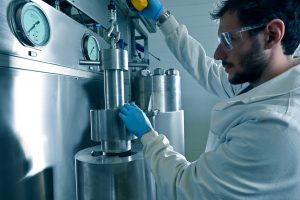
Following the extraction procedure, Exenia Group srl, provides various accessory processes, useful for separating the substances of interest more effectively and concentrating. Some of these have been optimized to remove the waxy component from the extracts. Waxes are complex and ubiquitous lipophilic molecules in the plant kingdom. They are a thorny issue in the extractive field, since they are distinctly apolar, with medium-high molecular weight and are extracted together with oil and other compounds, especially if a apolar substance such as supercritical CO2 is used as a solvent. In some cases the presence of these molecules in the extract is an added value, but in others it can only be a useless component that can complex and requisition other extracted substances from the oily solution. By removing the waxes, they can be affected by other post processes, useful for solubilizing the chemical compounds required in these lipid matrices. Some of these processes applied by Exenia are:
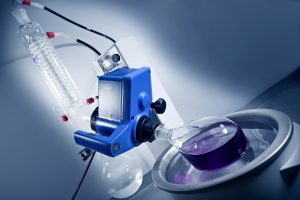 Centrifugation: by using the centrifugal force it is possible to reduce the sedimentation time of the substances dissolved in a mixture, having different densities. In this way, after setting some variables such as the number of revolutions per minute and the centrifugation time, the mixtures rich in waxes will be divided into precipitate (consisting of the densest solutes, and therefore heavier in terms of molecular weight, such as waxes) and supernatant (consisting of the least dense component). By taking only the supernatant, there is a removal of the precipitate, or of the waxes, which can be treated later.
Centrifugation: by using the centrifugal force it is possible to reduce the sedimentation time of the substances dissolved in a mixture, having different densities. In this way, after setting some variables such as the number of revolutions per minute and the centrifugation time, the mixtures rich in waxes will be divided into precipitate (consisting of the densest solutes, and therefore heavier in terms of molecular weight, such as waxes) and supernatant (consisting of the least dense component). By taking only the supernatant, there is a removal of the precipitate, or of the waxes, which can be treated later.- Winterization: the principle is always that of sedimentation, and of the separation of the mixture into supernatant and precipitate, but low temperatures are used to decrease the execution times. In fact, by modulating the temperature, the solvent properties of the mixtures are modified and the denser solutes will precipitate with greater speed, so as to allow separation by filtration.
- Purification with activated carbon: in this case the separation takes place by size. During the preparation of this method, active carbons in powder form are arranged inside a column, which will constitute the stationary phase and form a filter, with pores of different sizes, based on the particle size. The mixture to be purified is percolated through this filter, which will retain the molecules with larger dimensions than the pores. Subsequently, the substances retained by the stationary phase can be recovered using specific eluent solutions.
- Fractionation: of concentrated extracts of active ingredients (e.g. palm oil ration concentrate in tocopherol or vitamin E).
- Pasteurization at room temperature (30° C) for natural drinks and preservation of thermolabile vitamins and the aromatic characteristics of the alcoholic beverage
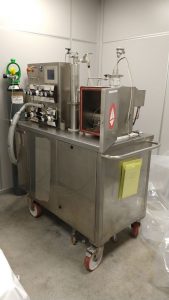 Micronization and microencapsulation through the application of the Joule Thomson effect combined with the mechanical transfer of the extract through a fine conduit (nozzle) capable of sizing the drug powders. This micronization technology is an innovative technology that does not use toxic solvents, capable of producing microparticles by exploiting sub-critical conditions of the CO2 used as an agent: in rapid expansion the gas subtracts heat from the extract, crystallizing the compound. With this technology, it is also possible to cover the products obtained in the form of regular-shaped powders and small diameter microparticles, with high bioavailability, with gastro-protective polymers. The microparticles can be composed of slightly soluble anionic lipids at acid pH, mixed with gastro-resistant polymers, polymers of the methacrylate type. In vitro drug release results generally indicate that gastro-resistant microparticles are able to delay the drug release process without achieving complete gastro-resistance.
Micronization and microencapsulation through the application of the Joule Thomson effect combined with the mechanical transfer of the extract through a fine conduit (nozzle) capable of sizing the drug powders. This micronization technology is an innovative technology that does not use toxic solvents, capable of producing microparticles by exploiting sub-critical conditions of the CO2 used as an agent: in rapid expansion the gas subtracts heat from the extract, crystallizing the compound. With this technology, it is also possible to cover the products obtained in the form of regular-shaped powders and small diameter microparticles, with high bioavailability, with gastro-protective polymers. The microparticles can be composed of slightly soluble anionic lipids at acid pH, mixed with gastro-resistant polymers, polymers of the methacrylate type. In vitro drug release results generally indicate that gastro-resistant microparticles are able to delay the drug release process without achieving complete gastro-resistance.
All these technological applications allow:
- production of extracts from high quality and high yield vegetable matrices, usable in food, cosmeceutical products, nutraceutical and pharmaceutical sector,
- replacement of conventional processes, reducing the environmental impact and significantly improving the quality of life of workers (for example: for the removal of toxic substances),
- increase in product innovation with significant increase in product efficacy and safety,
- influence the development of the agricultural value chain for the integration of secondary materials from the food processing industry due to the high versatility expressed in many industrial applications

